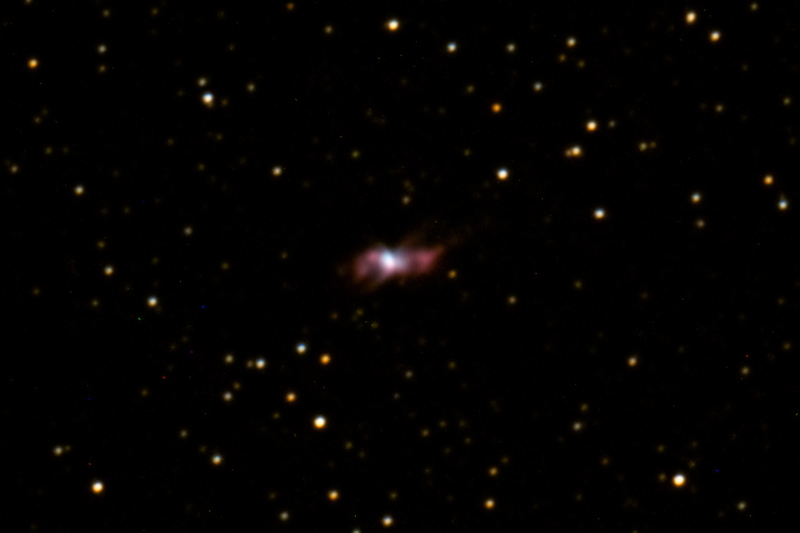
iPhone: Venus, Mars, Saturn; iPad DSO Observing;
D7000: M108, NGC4485/4490, NGC6302
Posted: 17 May 2012
I opened the observatory at 1819 MST, 95°F. I added a new flag to the observatory: Indiana. That's the blue flag beneath the Indiana University flag. Indiana is my home state, where I first started in astronomy. The flag to its left is Arizona, where I now live.

I then viewed Venus, 77X, and immediately set up for iPhone imaging. This is a stack of 895 frames (cropped) taken at 444X + moon filter. The image has been edited to show a more natural sky at the time of the video recording.

I then did some more Venus observing at 412X + moon filter. The previous night's re-collimation improved the view. Having the 8" LX200-ACF perfectly collimated again really helps. Even 727X showed a crisp view of the planet a few minutes before sunset. But the best view was at 364X.
At 1943 MST, I took a final look at Venus, 77X, and then moved to Mars. No details were visible at 77X. The view was better at 133X but best at 206X. Seeing was not good enough for 364X on Mars. With 206X, I could see the North Polar Cap, clouds along the limb, dark areas, and possibly the South Polar Cap. At 267X, the view was clear enough to decide it was the South Polar Cap I was seeing. The gibbous phase was very obvious at 267X. I did a 45 second video recording of Mars, afocal 444X + moon filter, with the iPhone 4. This is a stack of 1098 frames, cropped, not upscaled:

At 2013 MST, viewed Saturn, 77X. Four moons were visible: Titan, Rhea, Tethys, and Dione. I tried to pick up Enceladus at 133X, 206X, and 364X, but failed. The seeing was worse now. I captured this iPhone image of Saturn, stack of 1104 frames, 222X + moon filter, cropped and upscaled 200%:

Ended imaging at 2041 MST and connected the new iPad (Retina Display) to the telescope using the SkyWire serial cable. I then began using SkySafari 3.5 Pro to select various DSOs to observe and have it GOTO the objects. With SkySafari in control of the telescope, I viewed: NGC2997 (galaxy), NGC3247 (Ghost of Jupiter, planetary nebula), NGC4485/4490 (galaxies), M109 (galaxy), and M108 (galaxy). I ended iPad use at 2128 MST. It was very handy to be able to select an object from search lists or by just scrolling and tapping an object on the star chart.
I set up for DSO imaging with the D7000 DSLR at prime focus + Off-Axis Guider. I did a focus test using the Bahtinov Mask on the star Regulus. I next did a framing test exposure of M108 (galaxy); framing was not ideal but found a good guide star. This is a cropped, guided, 5 minute, ISO 6400, exposure:

Then slewed to NGC4490 (the brighter of the two interacting galaxies) and did a framing test. Again, not ideal framing but had a good guide star. This is a cropped, guided, 5 minute, ISO 6400, exposure of NGC4485 (left) and NGC4490 (right):

I ended imaging at 2213 MST, but left the camera mounted on the telescope in preparation for the next DSO imaging target. I slewed to NGC6302 (Bug Nebula, planetary nebula) and began waiting for it to rise high enough in the southeastern sky. While waiting, I did some sky observing with 7x50 binoculars, with music from the "Hearts of Space" playing in the background inside the observatory. Great music for stargazing!
At 2331 MST, I rechecked the focus using Antares and the Bahtinov Mask; made a slight focus adjustment. At 0000 MST, I began imaging NGC6302 (Bug Nebula) at various exposure lengths and ISO settings. This is a cropped, guided, 5 minute, ISO 1600, image:

NGC6302 was very low in the sky and so image quality is not that great. I ended imaging at 0026 MST. At 0038 MST, I observed NGC6302 at 77X. Visually, it is a faint planetary nebula but the oblong shape was evident. At 133X and 206X, using averted vision, some structure in the nebula was detectable.
Closed the observatory at 0051 MST, 70°F.
I received this from Southern Stars, developer of the SkySafari, SkyWire, and SkyFi:
We’ve just released a major update to our SkySafari apps (3.5) that lets you view events like this Sunday’s solar eclipse from the Moon – or anywhere else in the solar system. The iOS versions are out now; two of the three Mac OS X versions are out now as well, and we’ll release Android today or tomorrow.
Check their web site on 18 May for a video which illustrates everything.
Comments are welcome; use the Comments section below, or you can Email Me. Thanks.
Go to the previous report.
Return to the Cassiopeia Observatory Welcome Page.